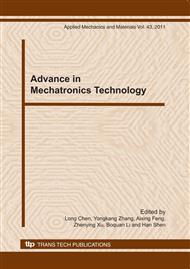p.594
p.599
p.603
p.610
p.614
p.619
p.624
p.628
p.633
Influence of La2O3 Doping Amount on Properties of NBT-KBT-BT Lead-Free Piezoelectric Ceramics
Abstract:
0.85(Na0.5Bi0.5)TiO3-0.144(K0.5Bi0.5)TiO3-0.006BaTiO3(NBT-KBT-BT) lead-free piezo -electric ceramics were prepared using conventional solid state method. The influence of La2O3 doping amount on the crystal phase, surface microstructure and properties of the NBT-KBT-BT lead free piezoelectric ceramics were investigated using X-ray diffraction(XRD), Scanning electron microscopy(SEM) and other analytical methods. The results show that La2O3 has diffused into the lattice of NBT-KBT-BT ceramics. Consequently, a pure perovskite phase is formed. SEM images show that the microstructure of the ceramics is changed with the addition of a small amount of La2O3, La2O3 doping can make grain growing. The piezoelectric strain constant(d33) starts increasing and then decreasing, the dielectric constant(εT33/ε0) increases continuously and the dielectric loss(tanδ) starts increasing and then decreasing and then increasing when La2O3 doping amount increases. When the doping amount of La2O3 is 0.4wt.% and the sintering temperature is 1160°C, the NBT-KBT-BT piezoelectric ceramics with good comprehensive properties can be obtained. Its piezoelectric strain constant(d33), dielectric constant(εT33/ε0), and dielectric loss(tanδ) are 151pC/N, 1543 and 4.2%, respectively.
Info:
Periodical:
Pages:
614-618
Citation:
Online since:
December 2010
Authors:
Price:
Сopyright:
© 2011 Trans Tech Publications Ltd. All Rights Reserved
Share:
Citation:


